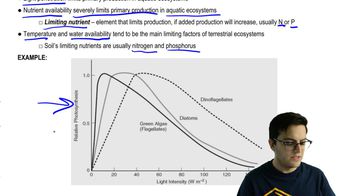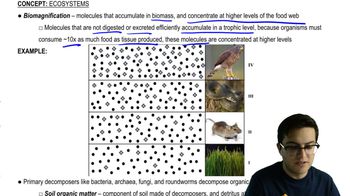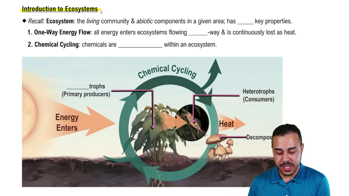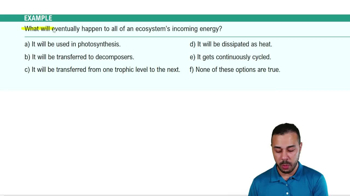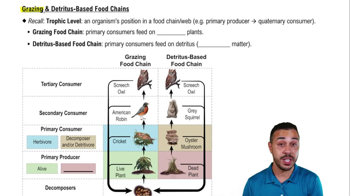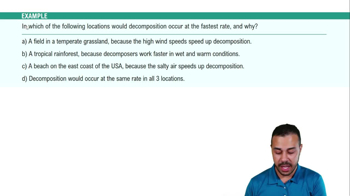Table of contents
- 1. Introduction to Biology2h 42m
- 2. Chemistry3h 40m
- 3. Water1h 26m
- 4. Biomolecules2h 23m
- 5. Cell Components2h 26m
- 6. The Membrane2h 31m
- 7. Energy and Metabolism2h 0m
- 8. Respiration2h 40m
- 9. Photosynthesis2h 49m
- 10. Cell Signaling59m
- 11. Cell Division2h 47m
- 12. Meiosis2h 0m
- 13. Mendelian Genetics4h 44m
- Introduction to Mendel's Experiments7m
- Genotype vs. Phenotype17m
- Punnett Squares13m
- Mendel's Experiments26m
- Mendel's Laws18m
- Monohybrid Crosses19m
- Test Crosses14m
- Dihybrid Crosses20m
- Punnett Square Probability26m
- Incomplete Dominance vs. Codominance20m
- Epistasis7m
- Non-Mendelian Genetics12m
- Pedigrees6m
- Autosomal Inheritance21m
- Sex-Linked Inheritance43m
- X-Inactivation9m
- 14. DNA Synthesis2h 27m
- 15. Gene Expression3h 20m
- 16. Regulation of Expression3h 31m
- Introduction to Regulation of Gene Expression13m
- Prokaryotic Gene Regulation via Operons27m
- The Lac Operon21m
- Glucose's Impact on Lac Operon25m
- The Trp Operon20m
- Review of the Lac Operon & Trp Operon11m
- Introduction to Eukaryotic Gene Regulation9m
- Eukaryotic Chromatin Modifications16m
- Eukaryotic Transcriptional Control22m
- Eukaryotic Post-Transcriptional Regulation28m
- Eukaryotic Post-Translational Regulation13m
- 17. Viruses37m
- 18. Biotechnology2h 58m
- 19. Genomics17m
- 20. Development1h 5m
- 21. Evolution3h 1m
- 22. Evolution of Populations3h 52m
- 23. Speciation1h 37m
- 24. History of Life on Earth2h 6m
- 25. Phylogeny2h 31m
- 26. Prokaryotes4h 59m
- 27. Protists1h 12m
- 28. Plants1h 22m
- 29. Fungi36m
- 30. Overview of Animals34m
- 31. Invertebrates1h 2m
- 32. Vertebrates50m
- 33. Plant Anatomy1h 3m
- 34. Vascular Plant Transport1h 2m
- 35. Soil37m
- 36. Plant Reproduction47m
- 37. Plant Sensation and Response1h 9m
- 38. Animal Form and Function1h 19m
- 39. Digestive System1h 10m
- 40. Circulatory System1h 57m
- 41. Immune System1h 12m
- 42. Osmoregulation and Excretion50m
- 43. Endocrine System1h 4m
- 44. Animal Reproduction1h 2m
- 45. Nervous System1h 55m
- 46. Sensory Systems46m
- 47. Muscle Systems23m
- 48. Ecology3h 11m
- Introduction to Ecology20m
- Biogeography14m
- Earth's Climate Patterns50m
- Introduction to Terrestrial Biomes10m
- Terrestrial Biomes: Near Equator13m
- Terrestrial Biomes: Temperate Regions10m
- Terrestrial Biomes: Northern Regions15m
- Introduction to Aquatic Biomes27m
- Freshwater Aquatic Biomes14m
- Marine Aquatic Biomes13m
- 49. Animal Behavior28m
- 50. Population Ecology3h 41m
- Introduction to Population Ecology28m
- Population Sampling Methods23m
- Life History12m
- Population Demography17m
- Factors Limiting Population Growth14m
- Introduction to Population Growth Models22m
- Linear Population Growth6m
- Exponential Population Growth29m
- Logistic Population Growth32m
- r/K Selection10m
- The Human Population22m
- 51. Community Ecology2h 46m
- Introduction to Community Ecology2m
- Introduction to Community Interactions9m
- Community Interactions: Competition (-/-)38m
- Community Interactions: Exploitation (+/-)23m
- Community Interactions: Mutualism (+/+) & Commensalism (+/0)9m
- Community Structure35m
- Community Dynamics26m
- Geographic Impact on Communities21m
- 52. Ecosystems2h 36m
- 53. Conservation Biology24m
52. Ecosystems
Introduction to Ecosystems
Problem 3`
Textbook Question
Which of the following is the longest-lived reservoir for carbon?
a. Atmospheric CO2
b. Marine plankton (primary producers and consumers)
c. Fossil fuels
d. Wood
 Verified step by step guidance
Verified step by step guidance1
Understand the concept of carbon reservoirs: Carbon reservoirs are natural storage places for carbon, and they vary in how long they hold carbon. Some reservoirs, like the atmosphere, cycle carbon quickly, while others, like fossil fuels, store carbon for much longer periods.
Consider the atmospheric CO2: Atmospheric carbon dioxide is part of the fast carbon cycle, where carbon is exchanged between the atmosphere, oceans, and living organisms relatively quickly, often within years or decades.
Evaluate marine plankton: Marine plankton, including primary producers and consumers, are part of the biological carbon cycle. They absorb carbon dioxide during photosynthesis and release it during respiration and decomposition, typically cycling carbon within a few years.
Analyze fossil fuels: Fossil fuels, such as coal, oil, and natural gas, are formed from ancient organic matter that has been buried and transformed over millions of years. They represent a long-term carbon reservoir, storing carbon for geological timescales.
Consider wood: Wood, as part of living trees and plants, stores carbon for the lifespan of the organism, which can range from decades to centuries. However, it is not as long-lived as fossil fuels, which store carbon for millions of years.
 Verified video answer for a similar problem:
Verified video answer for a similar problem:This video solution was recommended by our tutors as helpful for the problem above
Video duration:
3mPlay a video:
Was this helpful?
Key Concepts
Here are the essential concepts you must grasp in order to answer the question correctly.
Carbon Cycle
The carbon cycle is the process through which carbon is exchanged between the Earth's atmosphere, oceans, soil, and living organisms. It includes various reservoirs where carbon is stored, such as the atmosphere, biosphere, oceans, and geosphere. Understanding the carbon cycle is crucial for identifying which reservoir holds carbon for the longest duration.
Recommended video:
Guided course
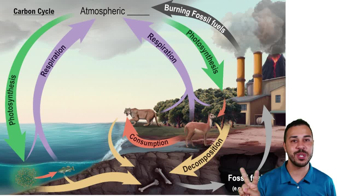
Carbon Cycle
Fossil Fuels
Fossil fuels are natural substances formed from the remains of ancient organisms, primarily plants and animals, over millions of years. They include coal, oil, and natural gas, and serve as a significant long-term carbon reservoir. The carbon stored in fossil fuels is released back into the atmosphere when they are burned for energy.
Recommended video:
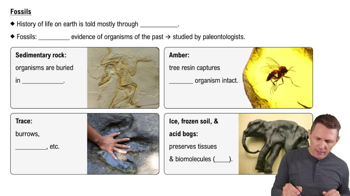
Fossils
Carbon Reservoirs
Carbon reservoirs are natural storage locations for carbon within the carbon cycle, including the atmosphere, oceans, living organisms, and geological formations. Each reservoir has a different capacity and duration for storing carbon. Fossil fuels represent one of the longest-lived reservoirs due to the slow geological processes involved in their formation.
Recommended video:
Guided course

Carbon

 4:07m
4:07mWatch next
Master Introduction to Ecosystems with a bite sized video explanation from Jason
Start learningRelated Videos
Related Practice





